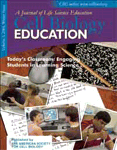Points of View: Lectures: Can't Learn with Them, Can't Learn without Them
Our knowledge of biology has been changing dramatically, yet most of us continue to teach biology the same way we have for the past century. In fact, teaching styles have not changed substantially since before the invention of the printing press. A current wave of reform in undergraduate science education has prompted many instructors to move away from a passive learning format in which the instructor attempts to convey knowledge to students through lectures and note taking. They are replacing this approach with ones that involve active learning. In this article, I describe my own conversion from teaching with a lecture format to the development of an active-learning approach (Klionsky, 1998, 2001; Klionsky and Tomashek, 1999). Along the way, I was introduced to several important concepts such as the difference between “teaching” and “learning,” the need to set learning goals and to utilize methods of assessment, and the value of becoming aware of the pedagogic research and adapting it to courses taught even at research-oriented universities.
RECOGNIZING THE PROBLEM
I have taught introductory biology for the past 15 years. For the first 6 years, I used a standard lecture format, and on the basis of student evaluations, the course was a success; I routinely received excellent scores for both the course and for me as an instructor. The course was“ working,” so what made me think I needed to change anything? Two recurring experiences made me wonder about the effectiveness of my approach. First, colleagues who taught upper division courses would occasionally stop me in the hall and make comments such as: “Didn't you cover transcription and translation in your course? I have students from your class and they don't even seem to know the difference.” Certainly we had covered those topics. And those comments were not unique to my course. Why was it that even the top students were not retaining a clear understanding of this material? The second revelation came from office hours. A student would come to see me expressing a total lack of understanding of a topic. I would explain the material to them and they would nod along. At the end of my explanation they would thank me and indicate that everything was now clear; however, if I asked them a simple question to verify their understanding, they were unable to answer, even though moments ago they had professed an understanding of what I had explained. What was going on? It occurred to me that what was happening in office hours was a microcosm of what was happening in my lecture course. I knew the material, and I could explain it in a clear and organized manner so that the students understood what I was talking about, but that did not mean my students were learning it. So what was the problem?
The problem had two origins: our students and us. This combination, which essentially amounts to an unstated collusion between instructor and learner, creates a pernicious and self-reinforcing cycle. As faculty members, we need to realize the difference between teaching and learning. Just because I was a good teacher did not mean that my students were learning. The research in learning and teaching makes it clear that lecturing promotes passive learning, and passive learning is not the most effective way to learn (Figure 1). In fact,“ passive learning is an oxymoron” (Leamson, 2000). There is increasing, and I would say undeniable, evidence that students learn better when they take an active role in the learning process (e.g., Cooper and Robinson, 2000; Davis, 1993; Lord, 1994, 2001; McKeachie, 1999; National Research Council, 2000; and references therein). Lecturing has its place (Bonwell, 1996); for example, it can be entertaining when carried out by a skilled practitioner. But lecturing is not a good approach when it is used as the sole or primary means of getting students to learn. The pedagogical literature has many examples of this point, so there is no need, and insufficient space, to reiterate it throughout this article — lecturing by itself is relatively ineffective as a learning tool.
We as faculty members are at fault because we are using an outdated methodology. Before the development of the printing press, the only way to transmit information was by word of mouth. With printed materials, and now electronic resources, other means of information delivery might be more effective. But there is plenty of blame to go around, because our accomplices in this educational deceit are the students. As one of my students once wrote,“ Education is the only business where the consumer is satisfied with less product.” In general, students do not prepare for class and they do not keep up. They have found it unnecessary for success in the course and they are pragmatists with many demands on their time. But these study habits have huge negative consequences for the course. Because my students did not read before class, I had no choice but to lecture to them; otherwise, they would not know what I was talking about. By not reading the book or studying their notes after class, they made it impossible for me to build on concepts presented in previous lectures; when I said, “As you remember from last time...,” they had no idea what we covered last time, and I was perfectly aware of that. In fact, there is often a tacit understanding between the students and the instructor: Don't expect too much of me and I won't expect too much of you.
I wanted to break out of this cycle that forced me to lecture, an ineffective method of teaching. But how should I teach and what approach should I use? My first insight came from a presentation in which I was introduced to the concept of constructivism. Constructivism states knowledge cannot be transferred from one person to another; knowledge must be created by each person in order for him or her to learn it. In addition, pedagogical research suggests that one of the best ways for students to learn is by teaching other students (McKeachie et al., 1986). Finally, as opposed to lecturing, active learning is an effective way to facilitate the acquisition of knowledge. I wanted to develop an approach that utilized these three concepts: 1) students must construct their own knowledge; 2) learning often works best as a collaborative effort; 3) active engagement in the learning process is critical. “Students learn best when they take an active role: when they discuss what they are reading, practice what they are learning, and apply concepts and ideas” (Davis, 1993).
However, I needed a method that recognized certain constraints. First, at a research university, the time I can devote to teaching is limited: If I devote excessive time to improving my teaching at the expense of my research, my career will pay the price. I wanted a method that was simple and that would fit within the time demands of an active researcher. It must be inexpensive because funds for improving teaching are limited. Finally, it must not depend on technological fixes, because the ability to implement technological changes might be limited. I wanted to develop a simple, low-cost, low-tech approach.
DEVELOPMENT OF AN ACTIVE LEARNING APPROACH
Given these conceptual goals and practical constraints, what method did I develop? Students could learn the basic material as well on their own as they could if I read it to them, which is essentially what I would be doing if I lectured. How could I get students to read the material prior to class? If I tried to reason with them and explained that lecturing was not an effective way to promote learning, they would read and keep up — for about the first week, until they got math homework and a chemistry quiz, etc., and then they would stop studying for my class until the midterm.
My solution was to give my students good notes. These notes are concise but complete; they are what I would say if I were lecturing to them. But the amount of reading is quite reduced compared with a standard textbook, perhaps an average of three pages per class hour; a standard text is available as an option for students who are willing to devote additional time to course preparation. Accordingly, I could demand that the students do this minimal amount of reading from my notes prior to class. I also included guideline questions to emphasize key points. For example, the reading for cellular energetics will include the following types of guideline questions:“ What is the purpose of fermentation (under what conditions does it happen)?” and “With regard to energy production, what is the main product of the TCA cycle?” To ensure that the students did the reading, I administered a reading quiz. This quiz was factual in nature and was meant to test whether they had read the notes. For example, a typical reading quiz would have the following types of questions: “What is the purpose of glycolysis?” and “What is the role of oxygen in the electron transport chain?” The reading quizzes were administered at the start of every class. This quiz constitutes approximately half of the course grade, so the students need to take it seriously (Figure 2).
Figure 1. Lecturing promotes passive learning. The students enter the classroom as blank slates and attempt to write down everything the teacher says without thinking. Doonesbury ©1985 G. B. Trudeau. Reprinted with permission of Universal Press Syndicate. All rights reserved.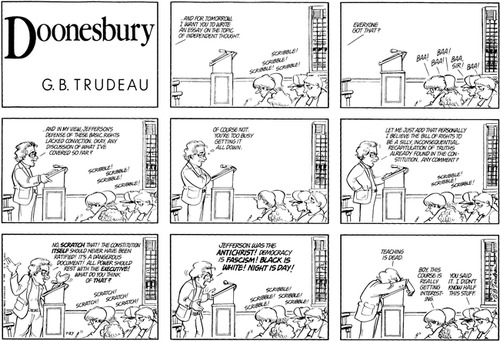
If I made no other change aside from instituting the reading quiz, I would have made major progress. The reading quiz forces the students to keep up, an unusual experience for most of them. Students have told me during the course how good it felt to be following along with the class. These students ask whether this approach — keeping up — would work for their other classes! When the students read ahead, they come to class with a certain sense of ownership of the material. They are no longer passive blank slates waiting to accept my words of wisdom. Most importantly, because the students have done the reading, I do not need to lecture. Typically, I will lecture for a few minutes, but the majority of class time is spent on problem solving.
We often teach as though the particular facts we are covering are critical when in reality there are few specifics that most students retain from their undergraduate education (Figure 3). Fortunately, retaining factoids is not as important as the learning concepts represented by factual examples or, more generally, learning how to think and solve problems. I want my introductory students to be scientifically literate, but I also want them to be able to think about problems that they have never encountered. Lecturing and note taking does little to develop such higher order thinking skills (Sorcinelli, 1991; Svinicki, 1999). In contrast, I break my class up into groups and put a problem up on the overhead projector. For the discussion of energetics, a problem might include the following: “Prokaryotes do not have a mitochondria like eukaryotes and therefore cannot use cellular respiration as a method of attaining energy. Is this true or false? Explain.” or “The TCA cycle does not use oxygen directly. Can the TCA cycle proceed in the absence of oxygen?” and “When an uncoupling agent such as CCCP is added to a flask of respiring tissue culture cells, oxygen consumption continues but little ATP is made. Why?”
I ask the class to discuss the problem within their groups and later ask for a group's answer. We hear each group's answer and discuss both the correct and incorrect answers — I want my students to see the thinking process that goes into solving the problem, not just to see which answer is right. I de-emphasize memorization. Certainly the students need to memorize some facts, but that is where the typical course ends. I emphasize using facts to solve problems. Unless we show our students how to gather, process, and apply information, they will not have learned very much that is useful beyond the course exams. To ensure participation in the problem solving, I administer a second quiz that is concept oriented and that constitutes the other half of the course grade. The concept quiz includes questions such as: “Describe what happens to your muscle cells if you exercise strenuously and run out of oxygen.” and “What is the effect of an uncoupler on ATP production through oxidative phosphorylation?” I administer this quiz at the start of the following class session so the students have some time to seek help if they are having difficulty. A typical day then consists of a concept quiz for the previous day of class, a reading quiz on that day's material, a short lecture and predominantly a problem-solving session.
EVALUATION OF THE ACTIVE LEARNING APPROACH
Does this method work? I have attempted to determine whether I have actually improved the course. First, I carried out an “objective” evaluation. To do this, I compared student performance on primarily fact-based, multiple-choice questions to evaluate the effectiveness of the active-learning format. Students who learned through the problem-solving format were asked to answer identical questions to those administered to students who were taught through a lecture format. Although this evaluation was undeniably biased in various ways, the results suggested that students learned information more effectively through the problem-solving format (Klionsky, 1998, 2001).
As a second method of evaluation, I compared these methods subjectively. In my experience, most faculty members devote little thought to the development of their own pedagogical approach (Klionsky, 2003). Although most people reading this article could easily think of various resources if they were trying to devise a protocol for an experiment in the lab, probably few could name even a single reference (aside from this journal) to guide them in pedagogical development. But such resources certainly exist. For example in 1986, a study was initiated that evaluated 50 years of research on teaching and learning (Chickering and Gamson, 1987). This study led to the proposal of “seven principles for good practice in undergraduate education.” The seven principles are only a guideline for instructors, but they have set a foundation for curricular revision across the nation. Below, I briefly compare the lecture and active learning formats with regard to the seven principles.
Figure 2. In general, students need an incentive to read the assigned material ahead of time. Cartoon copyrighted by Mark Parisi, reprinted with permission.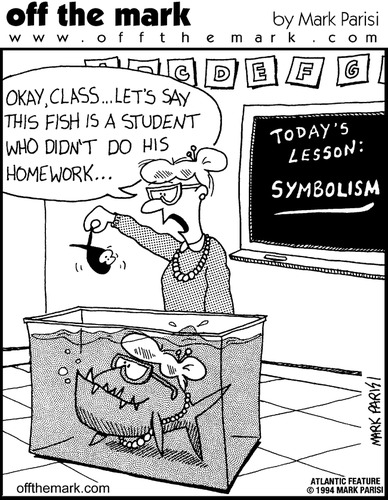
Good practice in undergraduate education:
Encourages contact between students and faculty. With the problem-solving approach, the instructor's role is primarily to facilitate group interactions while students discuss problems. The students have an opportunity to ask questions more freely and see the instructor in a different light. As a result, they become more willing to interact with the instructor. With this approach, the instructor sets the tone for an interactive environment rather than a oneway transfer of information from teacher to student as typically occurs during a lecture. Also, it is interesting to note that there is a high correlation between student-teacher interaction and teacher effectiveness, but a very low frequency of this behavior in natural sciences (Murray and Renaud, 1995).
Develops reciprocity and cooperation among students. Having students help each other learn is the primary featureof the group problem-solving format. In contrast, the lecture format typically focuses on individual competition: memorizing facts and getting high scores on the exams. For collaborative learning to be most effective, it is important to avoid grading on a curve; this eliminates a major aspect of competition (Kohn, 1992; Malacinski and Zell, 1995) so there is no disincentive to helping classmates learn.
Encourages active learning. The lecture/note-taking format is the epitome of passive learning. The approach that I describe encourages two types of active learning that might appeal to different types of students. First, students are responsible for reading the assigned material prior to each class session. They are encouraged to review their notes on a routine basis to prepare for the concept quiz following each topic. Reading and reviewing notes is a type of active learning that can be performed individually. Second, students actively solve problems during class time and in this case, active learning is cooperative.
Gives prompt feedback. Midterms are typically returned at least 1 week after they are administered, by which point the class is discussing a different topic. Final exams are returned after the end of the course, if at all. Generally, neither exam serves as a teaching tool, but rather as a means of summative evaluation. Research suggests that students remember information from a classroom presentation better when it is followed by a test (Menges and Mathis, 1988). Short and frequent quizzes can be graded quickly and returned to the students by the next class session. Quizzes quickly alert both the student and instructor to potential problems in comprehension. In contrast to typical midterms and final exams, quizzes provide a formative means of evaluation, and various studies suggest that this type of feedback is central to learning (Sorcinelli, 1991; Theall, 1999).
Furthermore, I will look at the quizzes as soon as they are collected. I can then make real-time course adjustments. Imagine a class in which you teach based on what the students have actually learned, compared with the standard lecture format in which your goal is to cover the information you have already chosen regardless of whether the students have learned any of it. The in-class problem solving provides an additional avenue for routine evaluation; students can get immediate feedback from their peers when working collaboratively. I provide additional feedback by asking for group responses and going over answers to each problem with the entire class after the discussions by the individual groups. This is in stark contrast to the lecture format, in which students usually do not receive routine feedback about their comprehension during the course of the lecture.
Emphasizes time on task. Not surprisingly, the more time that students devote to mastering a subject, the more they learn (Sorcinelli, 1991). Most students do not study for introductory biology on a routine basis. They allocate their time to meet other more pressing demands. They actively study only when an exam is imminent. The use of daily quizzes forces students to devote routine time to the course.
Communicates high expectations. Students generally appreciate high expectations as long as they are reasonable and if they are supported. The primary expectation of the lecture format is that students attend class and take notes. As a result, students expect to focus on memorization, with a tacit understanding that cramming for the exams is accepted. This “learn and burn” mentality emphasizes getting a good grade, not on learning or retaining the material. With the active learning strategy, students bear the major responsibility for learning. The frequent quizzes provide a set of routine and obtainable goals. When students perform well on these quizzes, they are motivated to continue making progress.
Respects diverse talents and ways of learning. People learn in different ways and active learning gives them the opportunity to work alone and in groups. Students are better able to retrieve information from long-term memory when it fits within the realm of their personal experiences (Svinicki, 1999); that is, the more relevant the material is to their own lives, the greater the likelihood that they will become engaged in the learning process and be able to remember it (Leamson, 2000). In addition, research suggests that the group approach benefits women and minorities (Anderson and Adams, 1992; Marchesani and Adams, 1992).
Figure 3. How much specific information do you actually remember from courses you took in college? For most people, the answer is very little. Usually the facts are not as important as learning how to use them; that is, developing the ability to ask questions, to find relevant information, and to use that information to solve a problem — in other words, developing critical thinking skills. Reprinted with permission. ©2004 Sidney Harris.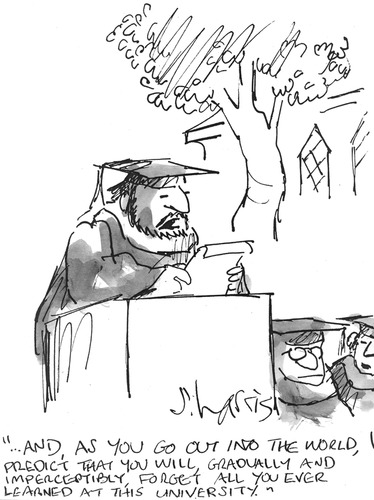
DIFFICULTIES (REAL OR IMAGINED) IN IMPLEMENTING ACTIVE LEARNING
The biggest variable in the learning process is what the students (learners) bring with them, not what the instructor provides. For this reason, it is important to use teaching strategies that motivate students and show them ways to actively learn long after they have left a particular course. In considering the above information, one question becomes obvious: If it is so clear that active learning is a better approach, why isn't everyone using it?
Faculty members do not know that there are alternatives. We teach the way we were taught, which was usually through a lecture and note-taking format. Also, few faculty members (particularly at research-oriented universities) read any pedagogical literature. Finally, many people are hesitant to give up control of their class; there is a comforting feeling being the“ expert” who has all the answers (Figure 4). Along these lines, there is a concern that the students will not participate in the active learning approach. I found that the students picked up my own conviction in the value of this approach.
As (research) faculty members, we are too busy. Many people think they do not have the time to make major changes in the way they teach; that is why I wanted to develop an approach that was not time intensive. It is also worth noting that the course material does not have to change completely or even extensively when changing to an active learning format. For example, I cover the same topics but my learning goals shifted from memorization of facts to developing scientific literacy and problem-solving skills.
Concern over depth of coverage versus breadth. Many instructors think that if time is spent solving problems in class, they cannot cover as much material. In fact, I cover as much with the active learning approach as I used to when I lectured; I just make the students take responsibility for learning part of the information on their own. In addition, I am not convinced that it is important to cover “everything” if the students are not learning anything (Figure 5).
We need to understand the difference between teaching and learning (National Research Council, 2000). Both students and teachers share responsibility for this confusion. Professors try to spoon-feed students, and the students keep asking for more; they don't want to take responsibility for learning. Also, the students want their tuition's worth, which they see as a lecture by an expert. We are evaluated on the basis of our performance as judged by students who don't necessarily have a long-term viewpoint. We should be evaluated on the basis of whether our alumni learned (National Research Council, 2003).
Large classes pose logistical problems. Some people think lecturing is the only possible way to handle a large class; however, I have used this active learning approach with a class of 240. Furthermore, when I taught in 50-min lectures, I had to cover a set amount of material and did not have a lot of time for interacting with the class. I always felt rushed as I tried to fit everything in during each class session. Now the students have already done the reading and covered all of the “essential” information. Whether I lecture for 5 or 10 min, and whether I cover 10 or 20 problems is not critical, so it is a much more relaxing experience.
There is a fixation on technology. Research suggests that technology for the purpose of education is often misused (Theall, 1999). Technology should not drive pedagogy and is only effective when there is a justifiable need for it. Many people equate technology with innovative teaching. For example, there is a common view that a multimedia approach such as the use of PowerPoint solves some perceived problems with the lecture format, although in my experience, few people use this software effectively for teaching (Lanius, 2004; McDonald, 2004; Voss, 2004). Furthermore, some instructors make their slides available ahead of time on the Web, allowing students to bring printouts to class to assist in taking notes. Although this sounds reasonable, I have found this approach produced unexpected problems. Several years ago, when I still used lectures as my primary means of teaching, I handed out my notes at the start of class then proceeded to lecture. Surprisingly, many students in the class complained and asked that I not hand out the notes beforehand. The problem was that some students would sit in class, “follow along” to the extent that they occasionally looked at the board to see where I was in my lecture, and talked with their friends; they were not paying attention to me because they “already had the notes” (McDonald, 2004), and they were interfering with the students who were interested in hearing the lecture. At any rate, the attitude that a change in presentation style will improve a course is somewhat laughable in light of the next point.
Most courses do not have explicit goals, so attempts to assess whether the course is meeting those goals are necessarily absent. Imagine conducting an experiment without evaluating the results. As research scientists, who would ever do that? Yet that is precisely the way weconduct our teaching (Klionsky, 2003). Do we objectively evaluate whether our students are learning? If we implement changes, do we have any way of determining whether they actually improved the ability of students to learn? The lack of goals and assessment (National Research Council, 2003) have led to the common acceptance of the lecture format because after all, “the current methods have “worked' for decades.”
Support and recognition for innovative teaching are lacking from colleagues, department chairs, or deans (National Research Council, 2003). Part of the academic culture at research universities is that serious scientists don't spend any more time than necessary on teaching.
Finally, I have to conclude with a simple question: do I advocate the elimination of all lecturing? The answer is, certainly not. I continue to lecture in my own course, although it is a minor part of the course. There is no single best way to facilitate learning, and lectures remain an effective way to deliver some types of information. But if you rely primarily on lecturing, I would have to ask another question: Do you know this is the most effective way to get your own students to learn? If you have not experimented with active learning, you cannot answer this question. As a scientist, why would you make an assumption that lecturing is meeting your learning goals without conducting the obvious experiment? We can't expect students to learn how to think scientifically when we don't apply the scientific method to our pedagogy (Klionsky, 2003). There is a trend away from teaching to learning, from a focus on facts and memorization to concepts and problem solving, from the use of passive to active learning formats, and from atmospheres that favor individual competition to ones that promote collaborative learning. These trends reflect ongoing changes in the way we do science, which is becoming more collaborative and interdisciplinary, in which we often work in teams and the focus is on conceptual problems and an effort to solve complex questions. At least with regard to introductory biology, the method I have described is much more effective than a lecture-style course at meeting these goals.
Figure 4. Active learning requires the instructor to be flexible because it involves continuous two-way communication between the instructor and the students. Students are encouraged to ask questions and are more likely to do so because they come to class prepared to discuss the material. Some faculty members might initially find this approach intimidating compared with the standard lecture format in which they control every aspect of the course. Reprinted with permission. Copyright CartoonResource.com.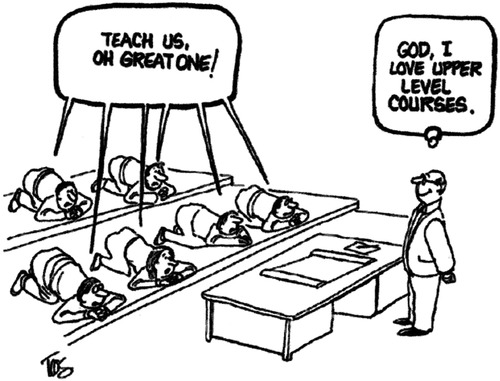
Figure 5. Many faculty members are convinced that it is critical to cover everything in the syllabus, whether or not their students are actually learning the material. Cartoon copyrighted by Randy Glasbergen, reprinted with permission.
ACKNOWLEDGMENTS
I thank Lisa Klionsky and Mary Lee Ledbetter and A. Malcolm Campbell for helpful comments on the manuscript. D.J.K. is supported by a grant from the National Science Foundation as part of the Director's Award for Distinguished Teaching Scholars.


